A 6-year-old girl with a severe skin rash
The Pediatric Infectious Diseases Service was consulted on a 6-year-old girl who was admitted to the medical center burn unit for treatment of a severe skin rash that began about a week earlier. About 48 hours ago, she had developed fever with chills and increased irritability. Urine and blood cultures were obtained prior to the consult and were both growing Klebsiella pneumoniae. Prior to the onset of the rash, she had been in good health, only having a seizure disorder previously diagnosed. She had recently been treated with phenytoin to obtain better control of her seizures. Within a few days of treatment with the phenytoin, she developed a rapidly spreading rash that necessitated her transfer to the burn unit.

Pediatric Infectious Disease, Scott and White's Children's Health Center and Associate Professor of Pediatrics,
Texas A&M University, College of Medicine, Temple, Texas.
e-mail: jhbrien@aol.com
On examination, a large proportion of her skin surface was dark with what appeared to be an eschar (figures 1–3). Her face, however, was relatively spared, and her eyes were inflamed with no appreciable discharge (figure 4). She had a urinary catheter in place and was receiving intravenous fluids. She was diagnosed with Klebsiella urosepsis, and it was recommended that the urinary catheter be pulled and treatment started with intravenous cefotaxime (a third-generation cephalosporin), based on sensitivities.
She was seen for the infection, but the skin condition was of equal interest.
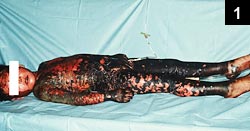
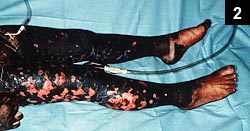
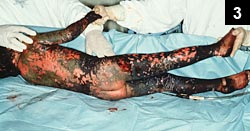
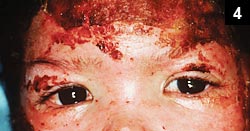
What’s Your Diagnosis?
- Staphylococcal Scalded Skin syndrome (SSSS)
- Kawasaki disease
- Stevens-Johnson syndrome
- Toxic Epidermal Necrolysis
Answer
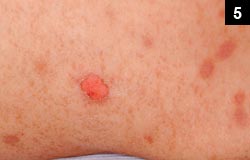
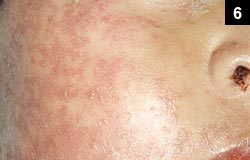
The answer is D, Toxic Epidermal Necrolysis (TEN). These patients are usually referred to burn units because of the depth of injury to the skin, which is subepidermal, or full-thickness, in many places. TEN is occasionally considered the same as severe Stevens-Johnson syndrome (SJS). The consensus among some academic dermatologists is that TEN and SJS are part of the same spectrum, whereas others believe that it is all part of the erythema multiforme spectrum, differing only in severity. Classification remains somewhat confusing. I think of SJS as a rash of varying severity, but not as severe as TEN, with at least two mucous membranes inflamed (eyes, lips, mouth, tongue, urethra, etc.). Blisters seen with SJS are typically short-lived because the depth of injury is fairly thin, resulting in a very fragile blister roof that ruptures easily (figure 5). There may also be smaller vesicle-like lesions in SJS, as seen in figure 6. Because of its deeper injury to this skin, patients with TEN are more likely to have intact blisters, with a sunburn-like rash when they first present, as shown in figure 7. Both conditions (TEN & SJS) are usually triggered by drugs, most commonly the sulfa antibiotics or anticonvulsants, however, many other drugs have been implicated as well. SJS may also be associated with infectious agents, such as herpes simplex, mycoplasma and many others.
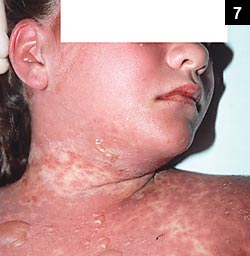
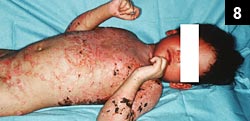
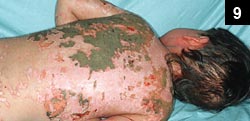
SSSS may appear very similar to TEN, with a generalized erythroderma and blistering. But as with milder SJS, the depth of injury is shallow, and there should be a focus of infection with Staphylococcus aureus found. If in doubt, a piece of skin can be lifted off the ruptured blister for the pathologist to stain and examine for the depth of injury, revealing a fairly quick answer. The treatment, of course, is support and an anti-Staph antibiotic, with removal or drainage of the source. Because of the shallow depth of injury to the skin, these SSSS patients do not require burn center management.
Kawasaki disease (KD) patients have a rash, but that is about where the similarity ends. The rash in KD can have a variety of appearances, but not blistering or vesicular, at least none that I have ever seen or read about.
I have one last lesson regarding these blistering diseases. As the mucous membranes, including the urethra, are often inflamed with these conditions, placing a urinary catheter can be dangerous, especially if left in too long. This opens a port of entry for organisms to get into the bloodstream through the damaged urethra mucous membrane barrier, leading to sepsis. So, my advice is to use urinary catheters only when absolutely necessary, and pull them as soon as possible.
The patient presented had a good outcome, recovering from her infection, and had relatively few areas that needed skin grafting (figures 8-9).
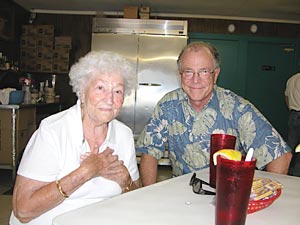
September 8, 1919 – December 26, 2006
Whether good, bad or in between, I am what she made me.
